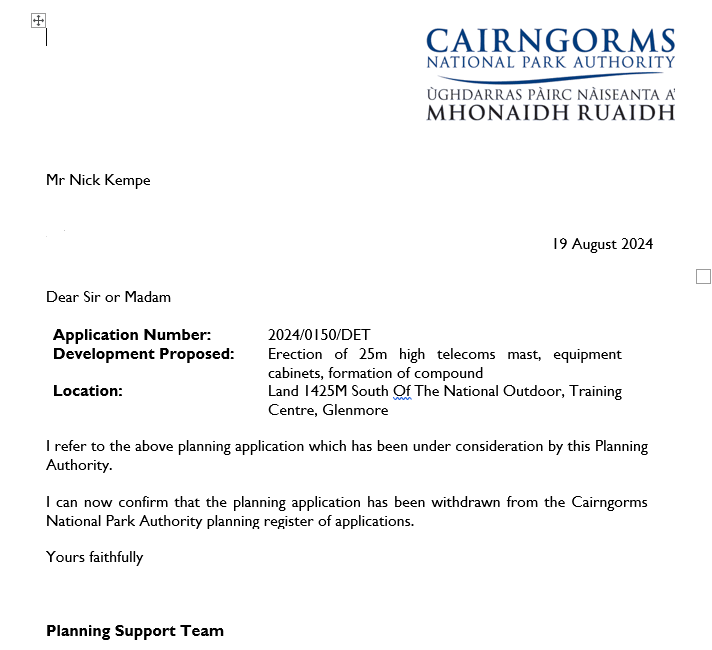
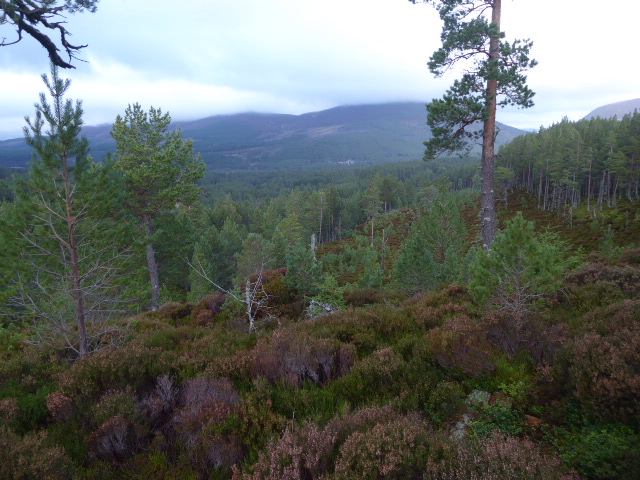
On Tuesday, 20th August, I and other objectors received this letter by email notifying us that the planning application for this 25m high telecommunications mast in the Glenmore Forest had been withdrawn. As usual, the description of the proposed development tells you little, but this is the “repeater” mast whose only purpose was to enable mobile operator Three to build its proposed mast by Ryvoan bothy (see here). As David Craig has subsequently shown, there was never any need for this “repeater” mast since O2’s mast at Lanchoil, east of Nethy Bridge, could provide signal to the proposed mast at Ryvoan……………so good news as someone asked me? Unfortunately not.
Undermining objectors
The Cairngorms National Park Authority (CNPA) letter only tells half the story:
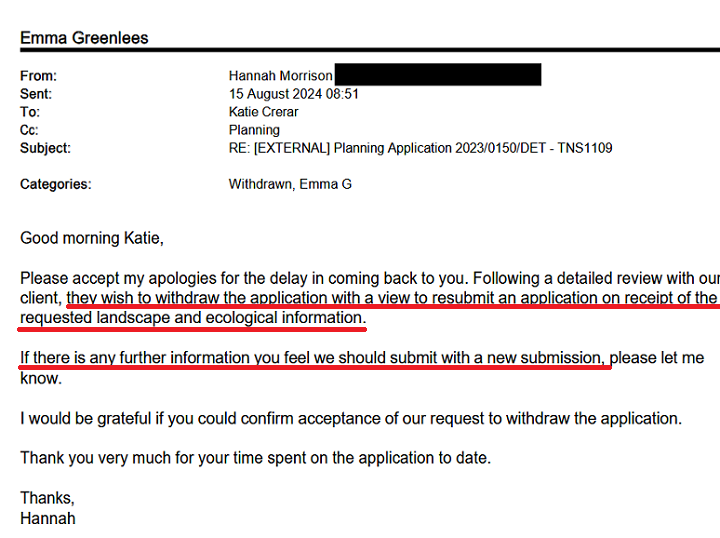
A check on the CNPA planning portal, where the withdrawal letter was published, shows the application has only been temporarily withdrawn. The fact that the CNPA have failed to tell objectors this is significant.
When a new application is submitted the planning process starts all over again. Comments on the previous application are completely disregarded and anyone concerned about a development has to submit a new objection. If a person led to believe an application has been withdrawn, rather than “temporarily withdrawn”, they are unlikely to look out for a new one. This greatly reduces the likelihood of them then submitting a valid objection when the application is re-submitted.
To address this problem I have in the past tried asking the CNPA’s head of planning, Gavin Miles, if they could notify past objectors to new applications (where these are similar to previous one) and people who inform them of unlawful developments of subseqent planning applicaations. It should be easy enough for the CNPA to do for past objectors using the same automated email system that informed me and others in this case that the application had been withdrawn. No such system has been put in place.
The CNPA works further against the interests of objectors by removing almost all the documentation about an application from their planning portal when it is withdrawn:
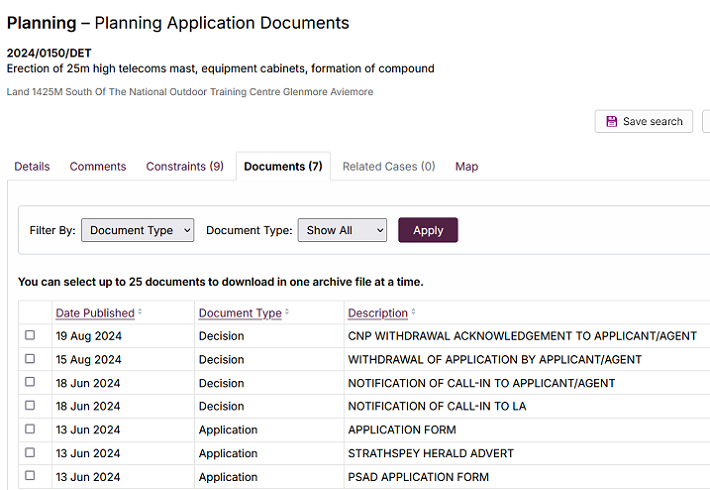
Without knowing which people and organisations objected to a previous application, those who stumble across a re-submitted application have no idea of who to alert. The removal of documents also makes it impossible for objectors to work out what might have changed in an application and select which bits to scrutinise. This means they need to read through all the documents all over again. All of this consumes time and appears designed to sap the will of the public to challenge planning applications.
The way the CNPA manages the planning system in the National Park is far from impartial and it also encourages developers to play cat and mouse with objectors, not just with telecommunications masts (see here) but hill tracks etc (see here) – Mitie, acting on behalf of Three, must be delighted!
How the CNPA is ignoring the fundamental flaws in the Shared Rural Network programme
Mitie’s letter shows that they have withdrawn the planning application because the CNPA has asked for more information about the landscape and ecological impacts of the mast. If there was any justification for this mast that might be reasonable. I had fortunately downloaded a copy of the Landscape and Visual Impact Assessment for the proposed mast at Glenmore before it was deleted from the planning portal. In 55 pages it manages to say almost nothing and besides a number of computer generated graphics contains just one photo:

Asking for more information on landscape and ecological impact is, however, completely irrelevant in this case and in the case of many other masts being proposed and funded through the Shared Rural Network programme.
In responding to the application various objectors had made the point that, based on the evidence of maps showing existing mobile coverage, it was not needed because the O2 mast at Lanchoil could do the job and mobile operators are supposed to share masts where possible. While it might have been reasonable for the CNPA to double check this evidence with Mitie/Three, it seems they didn’t as Mitie’s letters ask if there is “further information you feel we should submit with a new submission”. The answer is clearly YES!
In fact the ONLY information the CNPA needed to ask for in this case and needs to ask for in any future planning application is for maps of existing masts and coverage. Had the CNPA done that in the first instance there would never have been any justification for proceeding with the first application in this location let alone asking for a new one.
It appears the CNPA prefer to make work for themselves (potentially for very little reward because past enquiries have revealed they don’t charge full planning fees for repeat applications), for objectors and for Three and their agents. That may be of little concern to Three and Mitie because this planning application is being funded out of the £500m the UK Government has pledged to the mobile operators under to the Shared Rural Network programme. That doesn’t stop it being a complete waste of public money.
Implications of the Glenmore mast withdrawal
Logically, since the CNPA has failed to challenge Three’s claim that the repeater mast in Glenmore is necessary for the proposed mast at Ryvoan, they should now either suspend the decision-making process for the Ryvoan mast or worse suggest it be withdrawn. This helps illustrate the absurdity of the CNPA’s position and their lack of a strategic approach to the Shared Rural Network programme.
All the CNPA need to do is issue guidance to the mobile operators that they expect every planning application for a mast in the National Park to contain up to date information on existing and proposed masts and existing and proposed mobile coverage. The proposed mast at Ryvoan could then be decided on its merits while that for the repeater mast in Glenmore could be kicked into touch.
Yesterday, I checked the CNPA’s planning portal and counted over 120 objections to the Ryvoan mast (see here) (I took a screenshot just in case the application is withdrawn and all the objections removed from the planning portal). I know too that more people than this have attempted to submit objections but have been prevented from doing so because the CNPA’s standing orders limit public participation in the consultation process to the statutory minimum period of 28 days.
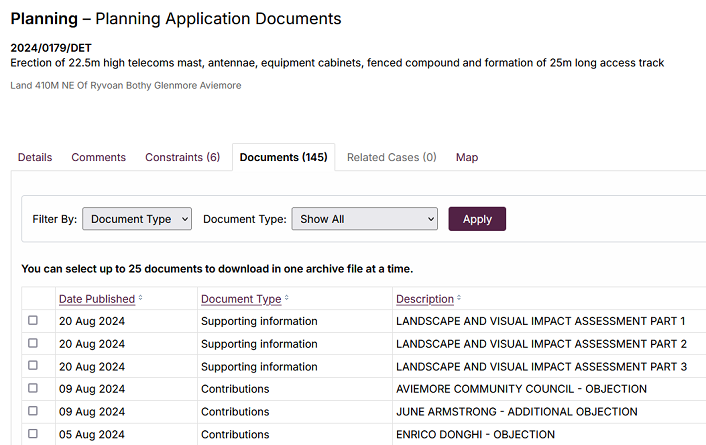
The last comment the CNPA has published on the planning portal from the public (they are all objections) was 9th August. But the CNPA has then published a Landscape and Visual Impact Assessment (LVIA) from 20th August for the proposed mast on 20th August on which the public are unable to submit comments. The CNPA operates one rule for developers and another for the public. The manifest unjustness of their system is highlighted in this case because the primary concerns about the proposed mast at Ryvoan are all about landscape.

The area of theoretical visibility shown in this map from the LVIA is basically the same as the area that would be provided with mobile signal. The CNPA, however, has still not required Three/Mitie to provide a map showing existing masts in the area and the coverage they provide. This would reduce the size of the Total Not Spot (the Ryvoan bothy for example already has 4G signal from various operators) shown in the Supporting Statement to the application and therefore the alleged “benefits” of the proposed mast. It would also allow the CNPA to assess the cumulative impact of these masts spreading across the landscape. So why are the CNPA planners not demanding such maps?
The need to reform the planning system in the Cairngorm National Park
The withdrawal of the Glenmore mast application together with how the Ryvoan application has been handled provides an excellent illustration of how the planning system as operated by the CNPA is not fit for purpose and is working against the public interest. Unlike Highland Council, which back in January expressed concerns about the SRN programme (see here), the CNPA has so far said nothing. As a National Park it should have taken a lead on challenging the SRN programme and the Ryvoan planning application, along with the unwarranted Glenmore mast, provides them a perfect opportunity to do so. Instead, the CNPA continues to facilate the mobile operators gaming the system anding play cat and mouse with the public.
The CNPA Board now needs to intervene and take control in the public interest and to ensure the statutory objectives of the National Park are met. It should issue clear guidance to both planning staff and the mobile operators that all applications for masts must include accurate information about other masts in the area and existing coverage. Doing so would stop much of the current mast nonsense that is going on in places like Glenmore. At the same time the CNPA Board need to review the way the planning system is being operated by staff in the National Park to make it transparent and fairer.
In my view if the CNPA Board fails to do this it is time to reconsider whether they should have the right to call-in applications from local authorities. The evidence to date is that Highland Council has handled applications for telecommunications masts far better than the CNPA, rejecting for example the application at Creagh Dhubh which CNPA staff failed to call in despite its significant implications for the landscape. It might therefore be better to limit the CNPA’s planning responsibilities to the policy matters and the production of the Local Development Plan while leaving the management of the sytem to councils.
As someone who was involved in the debates that led to the creation of National Parks in Scotland, many activists then thought control of the planning system was essential if the National Park Authorities were to meet their statutory objectives. In short, without control of the planning system, the risk was that the special qualities of the National Park would be adversely affected by development. Unfortunately, its not turned out like that and the record of our National Parks as planning authorities (whether masts or the amusement parks at Cairn Gorm and on the shores of Loch Lomond) is deplorable. The Scottish Government should review that record and the lessons to be learned before progressing any further with the proposed new National Park in Dumfries and Galloway.

As someone whose fingers have been welded to their keyboard for most of this year, I can only – regretfully – agree with everything you say. I’ve noticed that the RSPB, in its most recent comments on mast applications including Gleann Undalain and Orrin, has begun evoking Highland Council’s request for a pause/review of the SRN rollout and asking planners if they know what the current situation is. They clearly have major concerns. It would be nice if the CNPA could bring itself to share them.
Please be aware that the proposed mast at Creag Dhubh which was refused by Highland Council has been appealed…and one of the excuses reasons being cited on appeal is that CNPA did not raise any concerns during the first application. Laggan Community Council continues to object and the community should not have to suffer from CNPA’s lack of diligence.
Good luck using your mobilephones, smart meters & broadband in remote places. Just imagine being stranded around there.
Yawn. Virtually none of these proposed sites cover any permanent habitations anyway. And as a BBC Panorama programme the other night demonstrated, smart meters north of Manchester don’t use the cell network anyway.